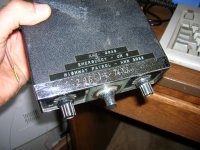
Click on the picture for a larger file

Click on the picture for a larger file
My 10m beacon project all started when my friend Chappy gave me an old Realistic Mini-23 CB. He didn't know if it worked or not and thought maybe I could do something with it. I had been thinking about building a 10m beacon for a while, and thought that this would make a good project. The top of the CB says:
KAGV 8048
EMERGENCY - CH 9
HIGHWAY PATROL - KNN 3083
296-14-7653
I connected a dummy load, hooked up a power supply, put in some headphones into the external speaker jack because I don't have a microphone to activate the internal speaker. Receive seemed to work fine. Then I poked around to figure out how to put it into transmit. By shorting the proper two pins together on the microphone jack, I could measure about 4 watts into the dummy load with my homemade RF probe. Everything seemed to work fine.
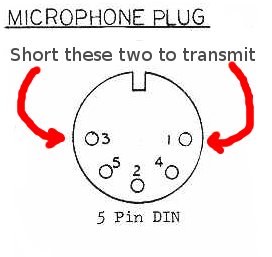
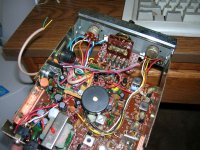
I've already installed the TiCK-4 keyer chip and removed the (8) 10 MHz crystals.
So now it was time to figure out how to get it on the 10m beacon sub-band. I wrote down the crystal frequencies to see what sort of mixing scheme it used.
| receive | X7 | X8 | X9 | X10 | X11 | X12 | X13 | X14 | |
| transmit | 10.180 | 10.170 | 10.160 | 10.140 | 10.635 | 10.625 | 10.615 | 10.595 | |
| X1 | 37.600 | 27.420 | 27.430 | 27.440 | 27.460 | 26.965 | 26.975 | 26.985 | 27.005 |
| X2 | 37.650 | 27.470 | 27.480 | 27.490 | 27.510 | 27.015 | 27.025 | 27.035 | 27.055 |
| X3 | 37.700 | 27.520 | 27.530 | 27.540 | 27.560 | 27.065 | 27.075 | 27.085 | 27.105 |
| X4 | 37.750 | 27.570 | 27.580 | 27.590 | 27.610 | 27.115 | 27.125 | 27.135 | 27.155 |
| X5 | 37.800 | 27.620 | 27.630 | 27.640 | 27.660 | 27.165 | 27.175 | 27.185 | 27.205 |
| X6 | 37.850 | 27.670 | 27.680 | 27.690 | 27.710 | 27.215 | 27.225 | 27.235 | 27.255 |
There were a couple of ways to get this radio into the beacon band. One was to get some crystals in the 9.440 to 9.480 range or 38.810 to 38.890 range. I made a spread sheet with some of the crystals that I could find on either surplussales.com or other sources. By changing one 37 MHz crystal to a 38 MHz crystal, I could get up to four frequencies within the beacon band compared to two with a 9 MHz crystal. If I could get four appropriate crystals, I could get a bunch of beacon frequencies to choose from.
While I was contemplating this, I came across WJ5O's useful page. He sent me a schmatic for the TRC-50, page 1 page 2 as well as a .pdf file of CBs that mix 23 MHz and 14 MHz to get 38 MHz which is mixed with a transmit oscillator at 11.275 MHz and receive oscillator at 11.730 MHz (455 KHz above the transmit). The advantage of this is that with one crystal change, you get 8 frequencies in the beacon band, each 10 kHz apart. Plus, I already had a crystal that would work, the 10.140 crystal from the Mini-23. So when I came across a TRC-52 for $8, I decided to grab it. The particular radio that I got had a toggle switch grafted onto the side. The seller said that he had no idea what it did. After taking the cover off, I could see two crystals, a 22.985 MHz and 23.085 MHz crystal soldered to the switch. I finally figured out that with the switch off, the radio worked normally on the 23 CB frequencies. With the switch on, channels 9-12 (23.390 kHz) and 17-20 (23.490 kHz) were moved down 23.390 - 22.985 and 23.490 - 23.085 = 405 kHz. Why he did this, I have no idea, maybe he and his CB buddies wanted their own private channels. Once I verified that everything was working properly, I brought the CB to school so I could use the oscilloscopes there. The 10.140 MHz crystal just had some tiny stubble for leads, so I soldered on a bit of thicker copper wire so it would make a good contact with the crystal socket in the radio.
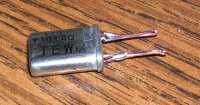
Click on the picture for a larger file
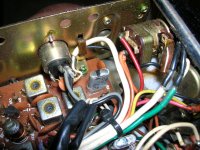
This is the 11.275 transmit oscillator crystal.
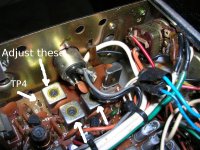
Here is the 10.140 crystal sitting in there.
When I powered up the radio and put it into transmit, the oscillator refused to oscillate on the new frequency. I figured that I needed to readjust the oscillator somehow, but couldn't get it to start. Finally I decided to take my 10.635 crystal from the Mini-23 and put that in the socket. I was hoping that it was near enough the original frequency to oscillate. That worked, by monitoring the oscillators output after the mixing stage at TP4, I could see a weak output. I peaked the three transformers marked with arrows above and then switched to the desired 10.140 crystal. In this way I could walk the oscillator down in frequency, instead of taking it all in one big jump. Now I had some output that I could work with!
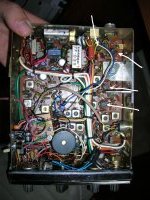
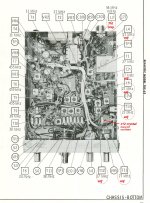
These are the inductors to retune the output for maximum power. Be sure to check TV channel 2 and 6 to minimize harmonic output!
After tweaking the output, I measured about 4 watts out. Not too shabby. Then all that remained was installing a keyer, packaging it up so it looked neat, getting an antenna up, and then flipping the switch! I took the TiCK-4 keyer out of the Mini-23 and wired it up to the TRC-52. I also replaced the power pigtails with a coaxial plug jack for power because it looked neater and I use that plug on almost everything else. I also printed out a nice looking sheet with the new frequencies and instructions for programming the keyer and taped it to the top of the CB.
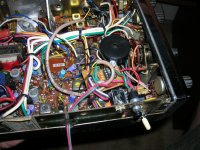
You can see the Tick4 wired up to the mic connector. The switch is so I can turn on and off the piezo speaker element. I'm waiting for a 5volt regulator, until then I'm running the power leads for the keyer out the side of the CB to a 3 cell alkaline pack. I've been using that same pack for something like 5 years now. It is down to 2.16 volts (less then .75v per cell!) and the keyer is still working fine.
I had forgotten how to program that TiCK-4 keyer, but I found all the information I needed online after much searching here
At first I put the radio in my attic and used an indoor dipole, the beacon was nicely rectified by my roomates subwoofer. He thought it was a bit strange when his computer suddenly started speaking to him in morse code. I moved the 10m dipole outside, strung it vertically in a tree, and fed it with about 70 feet of RG-58. Currently the beacon is running on 28.240 MHz and I'll move if I'm QRM'ing anyone. The beacon text is:
KC8HZM/B KC8HZM/B KC8HZM/B QTH HARRISBURG PA FN 10

The completed TRC-52 transmitting on 28.240 MHz.
I've got several improvements in mind. The keying seems to be a bit too clicky, I'll see if I can incorporate some RC time constant circuit to try and shape the waveform a bit better. I also just got some 10 and 38 MHz crystals in the mail all the way from Australia (thanks VK4MC!) so I can finish modifying the Mini-23. I could also potentially put the 10.595 MHz crystal in the rx oscillator spot, re-align the radio, and have a functioning 10m beacon transmitter and AM transceiver between 28.310 and 28.390! That would be fun to try.
I now have a 38.87750 and 38.84750 MHz crystal which will give me 28.2125, 28.2225, 28.2325, 28.2425, 28.2525, 28.2625, and 28.2825 MHz on the Mini-23. I could also put the 10.062 crystal in the TRC-52 and get 10 new frequencies if needed.
After graduating college in 2006, I took down my beacon, packed it up, and it stayed in storage for the next 8 years while I moved, changed jobs, got married, went to grad school and did a bunch of other things.
Finally in the summer of 2014 I had a place to setup a small operating table and string up a 10m dipole. I pulled out the beacon and put turned it on to 28.240 MHz again. To my surprise, within about 24 hours the beacon appeared on the WJ5O beacon list as uncoordinated!
28.2403 KC8HZM ? LANSDALE, PENNSYLVANIA # ?,? un-coordinated beacon reported 30 May 2014
I also received an email from WJ5O, who must keep very good logs:
Just as often as not my greyline bandscan is the best of the day...This evening no exception. ..... Poor conditions all this calendar until sundown..... Trans equtorial path, downunder and backscatter has filled out this log.... Good E propagation towards the Northeast..... A beacons for my log N5MIG....and one that "popped up" after a very long absence KC8HZM (Last heard 4 December 2005)
as well as kindly letting me know that as the coordinator, my 28.240 spot was no longer available in my region. So now the task was to move my frequency to an open position. As it was setup, the crystals locked me into an even 10 KHz channel spacing, along with most of the rest of the CB conversions. I thought that I had a crystal that measured a resonance at 10.062 MHz, giving me 28.287.8 which Bill told me was open in my region. So now my task was to move there. Unfortunately, the 10.062 crystal resonated at 10.060, not moving me off of the 10 KHz channel spacing. It turned out to be a 3rd overtone crystal for 30.180 MHz and was not amenable for bending very much. I tried adding capacitance in parallel with the 23 and 14 MHz crystals to bring those down, but as I got closer to 2 KHz of pull, the output of the oscillator decreased dramatically. It turned out to work better to raise the original 10.140 crystal by 2 KHz with a series 33pF capacitor. According to my FT-817, that put me just about zero beat on 28.287.8.
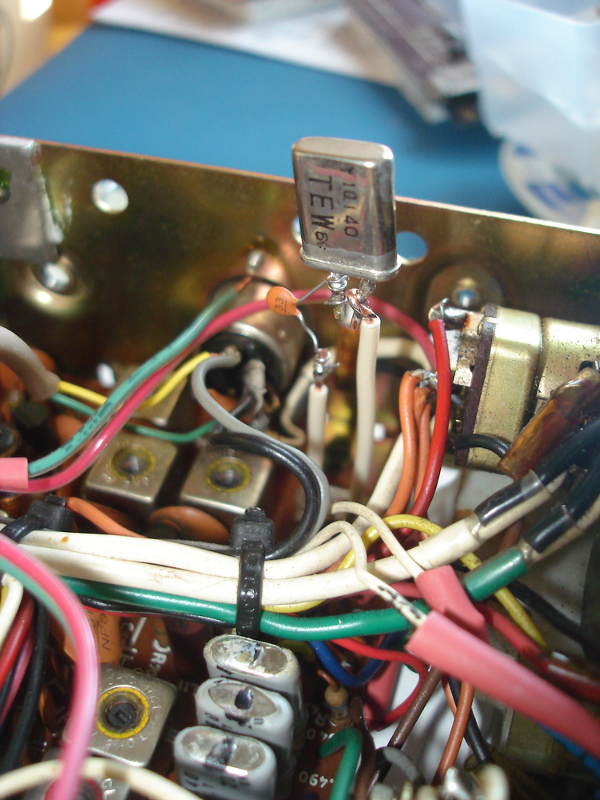
The next thing I wanted to do was replace the Tick-4 keyer with something else, because when it lost power, the beacon message was lost. I also wanted to replace the external AA battery pack. I quickly programmed a ATtiny13 and added a 5v LDO to take care of keying the beacon. Not pretty, but it worked.
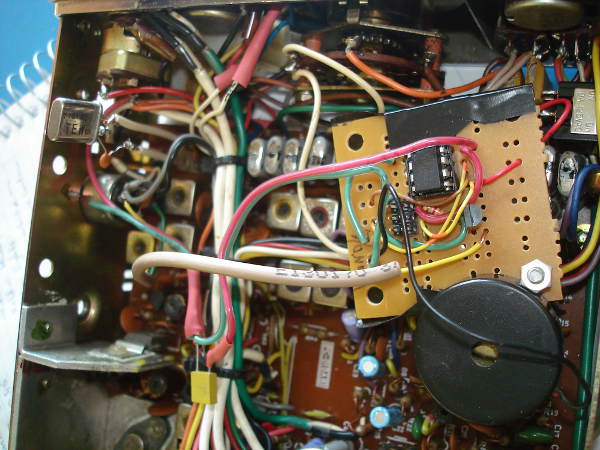
Shortly after starting up the beacon on the new frequency, I received the first official QSL from a shortwave DXer in Rossville, TN who confirmed my beacon on 28,287,04 kHz, the new message, and my speed at 12 wpm.
Many thanks for the QSLs, I'll do my best to respond!
Feb 23, 2015 Update: I have shortened the beacon message to be more concise, and waste fewer dits and dahs.
| ||||||||||